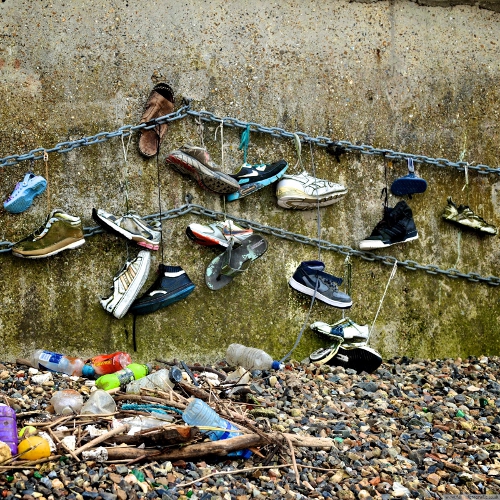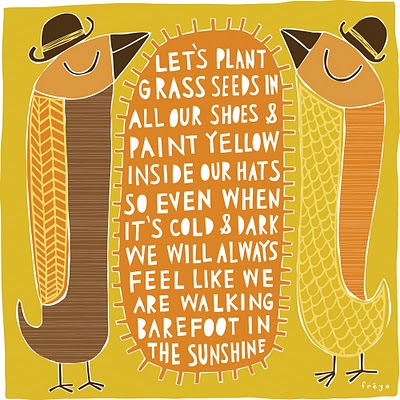It’s not that hard really…
There are two ways to start out on the road to running barefoot. One is to do it gradually, with a transition period using minimalist footgear, before taking the plunge into barefoot running proper. The other is to go ‘cold turkey,’ and throw your shoes away from the start. In this respect, cutting our addiction to running shoes is similar to stopping smoking. Different things can work for different people. But having taken the transitional route myself, I’d definitely recommend the cold turkey approach. The problem with transitioning through minimalist footgear is that it all too easily allows you to keep some of your old, bad running habits without noticing it – and this can lead to injury, as it did in my case.
Many people consider running in so-called ‘barefoot’ shoes because the thought of actually running barefoot doesn’t even occur to them. After a lifetime in shoes, trying out minimalist shoes make sense. But using our plain old bare feet? The thought is so alien and impossible that we don’t even get to the point of considering and rejecting the idea. If we do, though, all sorts of worries usually come up. How will my unprotected foot cope with the dirty and rough ground? Won’t I step on something sharp? (And what about doggy doodoo?…) What if I stub my toe? Blisters? Little psychological issues do pop up. No joking!
We’re afraid of the ground because we’ve lost our connection with it, as well as our connection with mother nature.
But don’t worry, you’ll be fine.
You just have to listen to your body.
The first thing that nearly everyone says to me is: ‘I guess I should start by running barefoot on grass.’ NO! As much as grass feels incredibly luxurious, it is the last surface you want to practice on.
The first place to run is on a good, hard, solid road or pavement. I’d argue that even a rubberized running track should wait for later.
1. You want something flat, predictable and even, in order to prevent damaging your ankle. After a lifetime in shoes, your ankle (as well as feet) muscles have seriously atrophied, and it takes time to build them back up again so you don’t get sprained.
2. You want a hard surface such as asphalt or even concrete to get the maximum feedback as to what mechanics are right and wrong (see article on form and mechanics). The problem with grass is that it feels wonderful no matter how you run! If you’re running properly, roads and pavements are entirely comfortable – yes, enjoyable! – and much more so than in shoes!
3. Flat: it goes without saying that hills are to be avoided in the beginning. Running hills barefoot will work your calf muscles and achilles tendon beyond what they were used to in shoes. You also run the risk of blisters and sore soles until your technique is up to scratch.
After everything is running smoothly on asphalt, there’s room to begin exploring other surfaces. But remember the basic rule: if it doesn’t feel good, it’s not good for you!
Having said this, there’s one exception. It’s completely normal that, during the first week or two, the soles of your feet will be completely oversensitized by the road beneath. It might sometimes even feel like running on pins and needles. In this respect, asphalt pavements are often much smoother than the asphalt on road surfaces, and will make the transition more comfortable. It isn’t so much a question of building up the skin on your soles – although this will certainly happen – but rather giving the nerve endings in your feet time to strengthen and adjust. Remember, they’ve been hibernating for a whole lifetime and are just waking up now.
The same pins-and-needles effect also occurred when I began running barefoot in the snow. After a few days, the nerve endings sorted themselves out, and now I’m fine – and actually love it!
The first time I ever ran without my ‘normal’ running shoes, I managed ten whole minutes – and even this pitiful achievement reflected a background in distance running. In retrospect, I realise that even ten minutes was too long. I woke up with pretty seriously sore muscles the next morning. But barefoot running felt so good that I kept ignoring the warning signs, day after day, pushing my body beyond its physical limits until I injured myself. Daah!
If you’re not already putting in a lot of shodden miles, you’ll have to start from the ground up. But here I believe everybody is different. You hear stories of people who take to barefoot running like a fish to water, and they can crank up the mileage immediately with faster times than ever before. I suspect, though, that these are exceptions to the rule. Most of us have to go slower. Much slower.
There are a million different methods discussing how to begin barefoot running. One of them might by right for you. The key thing, though, is to listen to your body. Only it knows what is right for you.
Here are some basic principles:
1. If you can’t walk barefoot without sore muscles the next day, you’re not ready to run barefoot. Try a twenty minute walk and see how it feels the next morning.
2. IMPORTANT: If barefoot running leaves you with sore muscles for more than a day or two, you’re overstressing yourself, and this could lead to injury. Back off!
3. Slow and short: if you’re an experienced runner, expect your times to be at least 10% slower, and expect to start with a maximum of 10% of your usual distance. Yes, you’ll be running about 90% less. If you’ve never run before, then only go as fast and as far as feels enjoyable. Yes, have fun!
4. Another 10% rule: after you’re up and running, increase your weekly mileage by a maximum of 10 percent.
5. Numbers are dangerous. The only truth is in the signals your body is sending you.
If you’ve never run before, you’re starting this adventure with a clean slate. But if you’re already a regular runner, then one of the first thoughts is bound to be: ‘if I have to start barefoot running with 90% less distance than before, I’m going to go crazy: what am I going to do!!!’ This is where more little psychological issues can rear their head. You’re might ask: ‘why am I addicted to running?’ Endorphins? Weight loss? Channeling of surplus energy? There are so many possible reasons…
Whether or not you decide to deal with these questions, you have two basic choices. One is to continue to running in shoes for a while, and gradually add in the barefoot miles. The other is to go cold turkey (again), and accept a temporary loss of miles. While continuing to run in shoes has the advantage of better maintaining your aerobic fitness during the interim, it will unfortunately confuse the body in terms of form and mechanics. And herein begins the danger of injury (again). So if you’re not totally addicted to your miles, I’d start from scratch and give your body a better chance of developing a good, natural barefoot running form.
How long will it take? I’d say anything from a few months to a couple of years. Yes, years. Is it worth it? The only way to find out is to try! My answer is a passionate YES!
Form and mechanics (click here for new article):



